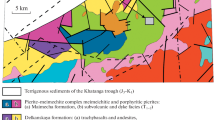Summary
¶A mineralogical classification of sulfides containing base metals (BM) and platinum group elements (PGE) is proposed based on BM-PGE ratios. Group A comprises BM sulfides carrying PGE as trace or minor elements (e.g., pentlandite). Group B is characterized by BM/PGE > 1 comprising kharaelakhite and some poorly defined minerals (thiospinels and monosulfides) which are described in detail. In group C, all sulfides with BM/PGE < 1 are summarized, comprising PGE-rich thiospinel, minerals related to the thiospinel group (e.g. xingzhongite, konderite, inaglyite), and the Pd-Pt±Ni sulfides.
A number of BM-PGE sulfides are described from podiform chromite occurrences in ultramafic portions of ophiolite complexes in the southern Urals (Kempirsai, Kazakhstan) and the Eastern Alps (Kraubath, Austria). Copper- and (Ir, Rh, Pt)-rich thiospinel (general formula AB2S4, with A = Cu, Ni, Fe and B = Ir, Rh, Pt) is present in complex assemblages in Kraubath, usually intergrown with laurite, Pt-Fe alloy and Rh sulfide. These thiospinels are commonly associated with lamellae and inclusions of Ni-and/or Fe-rich (Ir, Rh) sulfide showing either monosulfide or BM-rich thiospinel stoichiometry. In massive chromitite from Kempirsai, (Ni,Cu,Fe,Ir,Rh,Os) sulfides are intergrown with laurite-erlichmanite, Ir-Os alloy, and rarely, PGE sulfarsenides (e.g. irarsite), and usually have monosulfide (BM,PGE)S compositions. A small number of grains have (BM+PGE)/S matching PGE-rich thiospinel (cuproiridsite) and BM-rich thiospinel (Ni,Cu,Fe)1.5(Ir,Rh)1.5S4. In the occurrences studied, monosulfides exhibit sulfur-deficient stoichiometries (e.g., (BM,PGE)1−xS) and are characterized by BM/PGE ranging from 0.8 to 2.2. Although anisotropic in reflected light, their reflectance spectra (Y% = 33–38) differ only slightly from those of isotropic cuproiridsite and cuprorhodsite (Y% = 36–38). At least three groups of monosulfides can be distinguished on chemical grounds using literature data: monosulfides dominated by Ni and Ir (“iridian millerite”) with BM/PGE ranging from 1.6 to 5.9, monosulfides dominated by Fe and Rh (“rhodian pyrrhotite”) with BM/PGE ranging from 1.6 to 7.1, and monosulfides dominated by Cu, Ir or Rh (“xingzhongite”-type) with BM/PGE ranging from 0.6 to 1.1. While the first two types presumably crystallize in a hexagonal NiAs structure and exhibit extensive solid solution between each other, xingzhongite is cubic (BM-rich thiospinel?) and usually poor in Ni and Fe. Monosulfides and thiospinel may form from PGE-rich base metal sulfide liquids after cooling and equilibration in chromite-precipitating magmatic systems.
Zusammenfassung
¶Buntmetall-PGE-Sulfide aus dem Ural und den Ostalpen: Charakterisierung und Bedeutung für die Mineral-Systematik
In diesem Beitrag wird eine Einteilung von Sulfiden mit bedeutenden Konzentrationen von Buntmetallen (BM) und Platingruppenelementen (PGE) aufgrund ihrer BM/PGE-Verhältnisse vorgestellt. Gruppe A enthält Buntmetallsulfide mit Spuren- oder Nebenelementgehalten von PGE (z.B. Pentlandit). Sulfide der Gruppe B sind charakterisiert durch BM/PGE-Verhältnisse > 1, z.B. Kharaelakhit sowie einige schlecht definierte Minerale (Thiospinelle und Monosulfide), die im folgenden näher beschrieben werden. In Gruppe C werden alle Sulfide mit BM/PGE < 1 zusammengefasst, wie z.B. PGE-reiche Thiospinelle, einige mit Thiospinell verwandte Minerale (z.B. Xingzhongit, Konderit, Inaglyit), sowie die Pd-Pt±Ni Sulfide.
Verschiedene BM-PGE Sulfide treten als Einschlüsse in ophiolitischen podiformen Chromiten im Südural (Kempirsai, Kasachstan) und in den Ostalpen (Kraubath, Österreich) auf. In Kraubath sind Cu- und (Ir, Rh, Pt)-reiche Thiospinelle (generelle Formel AB2S4, mit A = Cu, Ni, Fe und B = Ir, Rh, Pt) in Verwachsung mit Laurit, Pt-Fe Legierungen und Rh-Sulfiden recht häufig. Soche Thiospinelle sind manchmal mit Lamellen und winzigen Einschlüssen eines Ni- und/oder Fe-reichen (Ir, Rh)-Sulfids assoziiert, das stöchiometrisch entweder einem Monosulfid oder einem BM-reichen Thiospinell entspricht. In massiven Chromititen von Kempirsai sind (Ni, Cu, Fe, Ir, Rh, Os)-Monosulfide mit Laurit-Erlichmanit, Ir-Os Legierungen und selten PGE-Sulfarseniden (Irarsit) vergesellschaftet. Die (BM+PGE)/S Verhältnisse einiger Körner entsprechen denen von PGE-reichem Thiospinell (Cuproiridsit) bzw. BM-reichem Thiospinell [(Ni,Cu,Fe)1.5(Ir,Rh)1.5S4]. In den meisten Fällen weisen die Monosulfide leichte Schwefeldefizite auf [z.B. (BM,PGE)1−xS] und sind charakterisiert durch BM/PGE Verhältnisse von 0.8 bis 2.2. Obwohl sie im Auflicht, soweit erkennbar, schwach anisotrop sind, differieren ihre Reflexionsspektren (Y% = 33–38) nur schwach von isotropem Cuproiridsit und Cuprorhodsit (Y% = 36–38). Zumindest drei chemische Gruppen von Monosulfiden konnten anhand einer Literaturrecherche identifiziert werden: Ni- und Ir-dominierte Monosulfide (“Iridium-Millerit”) haben BM/PGE Verhältnisse von 1.6 bis 5.9; Fe- und Rh-dominierte Monosulfide (“Rhodium-Magnetkies”) haben BM/PGE Verhältnisse von 1.6 bis 7.1; Cu-, Ir oder Rh-dominierte Minerale vom “Xingzhongit-Type” habben BM/PGE-Verhältnisse von 0.6 bis 1.1. Die ersten beiden Typen kristallisieren wahrscheinlich in einer hexagonalen NiAs-Struktur und weisen weitgehende Mischbarkeiten miteinander auf. Xingzhongit dagegen ist kubisch (BM-reicher Thiospinell?) und hat general niedrige Ni- und Fe-Gehalte BM-PGE-Monosulfide und Thiospinelle bilden sich wahrscheinlich aus kleinen PGE- und BM-reichen Sulfidschmelztropfen bei der Abkühlung und Äquilibrierung von Chromit.
Similar content being viewed by others
Author information
Authors and Affiliations
Additional information
Received June 17, 1998;/Revised version accepted July 1, 1999
Rights and permissions
About this article
Cite this article
Melcher, F. Base metal – platinum-group element sulfidesfrom the Urals and the Eastern Alps:characterization and significance formineral systematics. Mineralogy and Petrology 68, 177–211 (2000). https://doi.org/10.1007/s007100050009
Issue Date:
DOI: https://doi.org/10.1007/s007100050009




